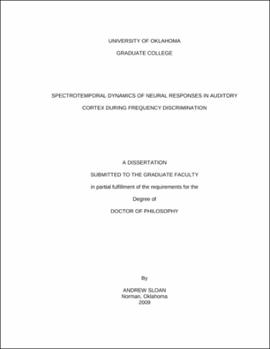| dc.contributor.advisor | Rennaker, Robert L | |
| dc.creator | Sloan, Andrew Michael | |
| dc.date.accessioned | 2019-04-27T21:32:59Z | |
| dc.date.available | 2019-04-27T21:32:59Z | |
| dc.date.issued | 2009 | |
| dc.identifier | 9928720002042 | |
| dc.identifier.uri | https://hdl.handle.net/11244/318974 | |
| dc.description.abstract | Small differences in the frequencies of a sound provide a significant amount of information about the identity, position, and motion of the source. Humans' auditory frequency discrimination ability also allows us to understand the subtle modulations that comprise spoken language. It should not be surprising, then, that deficits in auditory frequency discrimination ability have been often implicated in various language learning disorders. Understanding the neural basis for such deficits is difficult because the processes underlying auditory frequency discrimination haven't been fully identified. Recent evidence suggests that primary auditory cortex may be the ultimate arbiter of behavioral frequency resolution, but the frequency- and intensity-dependent properties of phasic-type responses most often seen in primary auditory cortex neurons do not correspond well with psychophysical trends. Tonic-type response components that occur after the phasic component in primary auditory cortex neurons may display frequency-selectivity more consistent with observed psychophysics, but are not yet well characterize in most animals. Studying the contribution of tonic responses to frequency discrimination behavior requires an approach that can examine both neural activity in primary auditory cortex and psychophysics in the same animals. | |
| dc.description.abstract | This dissertation presents the results of three experiments designed around the unifying hypothesis that tonic neural responses in primary auditory cortex are crucial for fine-grained frequency perception. The experiments involve both psychophysical measurements from behaving rats and in vivo, unanaesthetized neural recordings from primary auditory cortex. These techniques are ultimately combined to connect frequency discrimination behavior with the directly associated cortical neural activity. | |
| dc.description.abstract | In general, the psychophysical results show that rats have behavioral frequency discrimination acuity comparable to other mammals and are a suitable model for frequency discrimination research. Neural recordings from passively-listening animals show that rat primary auditory cortex neurons respond with both phasic and tonic components to pure tone stimuli as have been seen in other animals. When neural responses are recorded from primary auditory cortex of rats performing a frequency discrimination task, attention to the task enhances suppression during the beginning of the tonic response component, presumably to better sharpen frequency-selectivity. Furthermore, changes in spikerate during this post-phasic response component are significantly correlated with the corresponding psychophysical performance on the frequency discrimination task. The post-phasic component of neural responses in primary auditory cortex, the initial part of the tonic response, may directly encode behavioral resolution for frequency discrimination. | |
| dc.description.abstract | The results of these studies suggest that attention-modulated mechanisms of inhibition in the cortex are crucially involved in auditory frequency discrimination. Intriguing avenues of research radiate from this conclusion, from the possibility of correcting auditory deficits with inhibition-targeting interventions to the possibility of using frequency discrimination as a diagnostic method to identify more global inhibitory deficits. | |
| dc.format.extent | 155 pages | |
| dc.format.medium | application.pdf | |
| dc.language | en_US | |
| dc.relation.requires | Adobe Acrobat Reader | |
| dc.subject | Auditory cortex | |
| dc.subject | Audiometry | |
| dc.subject | Neuroanatomy | |
| dc.subject | Auditory perception | |
| dc.title | Spectrotemporal Dynamics of Neural Responses in Auditory Cortex During Frequency Discrimination | |
| dc.type | text | |
| dc.type | document | |
| dc.thesis.degree | Ph.D. | |
| ou.group | College of Engineering::School of Chemical, Biological and Materials Engineering | |
